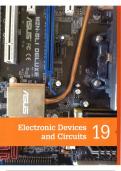Summary
Summary Unit 6 - Microcontroller Systems for Engineers electronic devices revision guide
- Institution
- PEARSON (PEARSON)
Unit 6 - Microcontroller Systems for Engineer's electronic devices revision guide includes all the necessary details that are necessary knowledge for the exam. I can reassure you that this is a distinction grade resource with more than extra notes and explanations to ensure that you get the best gr...
[Show more]




